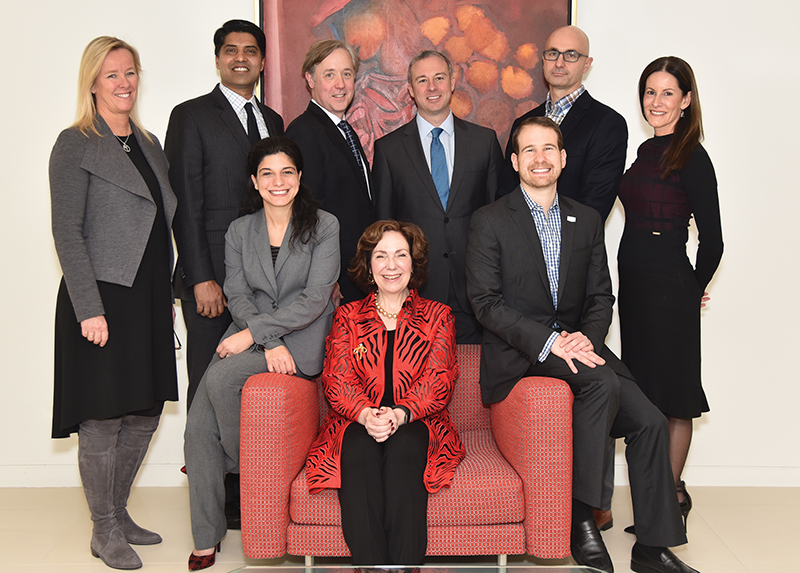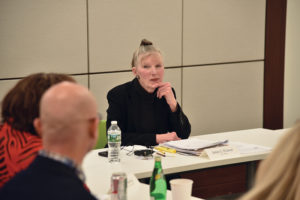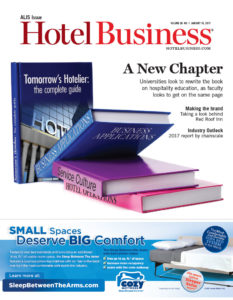
STANDING, LEFT TO RIGHT: Susanna Freer Epstein, IHG; Naveen Kakarla, HHM; Jeffrey Dauray, RLJ Lodging Trust; Jamie Russo, Choice Hotels International; Christopher K. Anderson, Cornell School of Hotel Administration; and Kathleen Chiechi Flores, Trump Hotels SITTING, LEFT TO RIGHT: Christina Komporlis, The Wall Street Journal; Dorothy Dowling, Best Western Hotels & Resorts; and Noah Brodsky, Wyndham Hotel Group
NEW YORK—What are guests looking for with regard to loyalty programs—value-based rewards? Aspirational ones? Both? How do programs intersect with guest service and company culture? What role will technology play in loyalty and how do third-party booking channels factor in? These are all questions the industry is facing, and they’re all questions that were tackled during “The New Face of Loyalty,” a Hotel Business executive roundtable that was held here recently, sponsored and hosted by The Wall Street Journal, part of Dow Jones & Company. Stefani C. O’Connor, executive news editor, Hotel Business & managing editor, roundtables, moderated the panel discussion.
“Loyalty fatigue is definitely a trend that’s coming up on all of us,” said Noah Brodsky, SVP, worldwide loyalty & engagement, Wyndham Hotel Group. “Some of the research has it that the average American now has 28 loyalty memberships across all of the work that they do but can only remember seven of them. The question for all of us: How do I become one of those seven? We’re all challenged to find ways to…create that emotional connection with people.” He added that the challenge is to create a culture in which guests think about your program not just when they’re traveling, but when they’re thinking about traveling “which happens a lot more often. Those are great opportunities for someone to think about our loyalty program: Do I have enough stays? Do I have enough points so that I can use that program for something that’s really important to me, which is getting away with my family?”
Christina Komporlis, general manager, membership, The Wall Street Journal, likened loyalty in hospitality to loyalty in publishing, noting that when her publication revamped its program, it found that “like a lot of other companies, we were falling into a pattern of getting really hyper focused on bringing people into the franchise, but then not doing a whole bunch to actually keep people on for years and engender that loyalty. We started looking at how we can create a membership because people will be more loyal, and that means better lifetime values of our customers, but it also means rather than be a transactional part of someone’s life, it’s more a statement about who they are.” The company took a look at its customers and realized they had one thing in common across the board—ambition. “We’re still learning what are the things we should be offering, but we’re always trying to make sure that it’s not discounts you can get anywhere, but it’s getting people closer to the brand and helping them fuel their ambitions, whatever those ambitions may be,” she said.
The panelists debated whether hotel companies were headed in the right direction to generate that loyalty. “We get confused about what we’re trying to do with loyalty programs. When you look at the ones that are very successful, they are really simple and there’s a lot of value,” said Christopher K. Anderson, director, center for hospitality research, Cornell School of Hotel Administration. “Where we get into a problem with loyalty programs is when we have to add layers to the program to go across segments and that confuses that value proposition. We’re going to see that in the hotel space very clearly over the next couple of years as Marriott tries to integrate SPG, given they haven’t fully done so with Ritz yet.”
However, Dorothy Dowling, SVP/CMO, Best Western Hotels & Resorts, noted that most hotel loyalty programs had evolved in terms of bringing more value to the customer. “I don’t think it’s all that complicated; it’s a 10 to 1 currency value for the most part. It was really about us leaning into [our]partners and broadening opportunities for redemption,” she said.
One thing hoteliers agree they do not want to do? Be like the airlines. “We’ve fallen into a trap of following the airlines. By doing that, we’re only concentrating on these elite travelers, creating these experiences like aspirational gifts, but that’s really only available to less than 1% of your loyalty program, let alone the rest of the 99% of the country that our hotels serve,” said Jamie Russo, VP, loyalty programs & customer engagement, Choice Hotels International. “For us, it was all about how do we deliver more value on day one. You join our loyalty program and you get up to 7% off your stay. If you join and stay with us during the week, we give you something immediately when you check in and you get to choose—extra points, extra miles or you can get an Amazon credit, an Uber credit.”
Brodsky agreed. “As an industry, it’s tricky because everybody wants to be special at the front desk and everybody wants a trophy just for booking a room and showing up. As an industry, we’ve got to decide are we going to create a culture of have and have-nots—which the airlines have doubled down on. If you’re not an airline elite, it’s a miserable experience,” he said. “On the one hand, we all as loyalty professionals certainly get the economics of those decisions, but as hoteliers, we’re all trying to take a more humane route with the way we’re trying to treat every customer with some level of specialness. To do that on scale across the 20,000 hotels that are represented just in this room is really difficult, and we’re all working through ways you can treat every single guest special through data, technology, front desk training and operations, but also through making sure expectations are set that you know what you’re going to get when you’re going to one brand or another.”
“That’s about culture,” said Susanna Freer Epstein, SVP, customer loyalty marketing, IHG. “That’s about a mindset of wanting to stand next to the person and really be side by side with them. It’s a culture element of our industry that we almost have to reignite a little bit more because it is at the heart of that. If you think like that, you will make the right decisions and your guest will feel really special when they meet you.”
“As Noah hits on, it doesn’t have to be that you over-incent those high-revenue people. It could be more about expanding the funnel,” said Russo. “I think that’s the direction a lot of us are trying to go is to provide more value to people starting on day one. You don’t have to be an elite.”
“It’s scary to see some of the brands go in the direction of airlines where they create a perk that was previously free and then start charging the bottom end of the hotel tiers for it,” added Brodsky. “I think it’s a dangerous trend in our industry that we certainly hope doesn’t become more widespread than it already is.”
Naveen Kakarla, president, CEO, HHM, noted that highlights the major difference between hospitality and airlines. “The problem we speak about with the airlines is not that they have an enhanced offering. It’s that their base offering is not acceptable to so many non-marathon travelers,” he said.
“There’s an element of what may sound glib, but it’s about bringing humanity back into loyalty,” said Epstein, noting that guests want to be listened to and they want to know that what’s delivered will be what they ask for and not something else entirely. “It’s being really laser-like focused on the analytics, really digging down in that and having that as a driver so we for the first time can tailor something that feels unique to me, but the way we deliver it is not mechanical,” she said. “That’s where that instant gratification of recognition is so important.”
“When I think about our lifestyle hotels, why people are staying in them and what we want to provide them, we think that simple tenet of recognition and belonging drives some of what we do from a loyalty perspective,” added Kakarla, noting that while guests want to know that redemption is possible, they’re just as focused on experience. “We’ve actually translated into fully calling it a perks program. Redemption is there and there’s simplicity around the redemption, but what we’ve found is to the extent we want to know our customer, want to delight them on that stay, want to do something that they will remember and ideally put up on Instagram, it requires us to tailor the offering to be something that benefits them that stay.
“It can be something as simple as a local amenity or an opportunity to access food & beverage, but we’ve really simplified what they can do on that stay,” he continued, noting this provides a way to really know the customer and generate return stays and direct bookings. This, Kakarla noted, requires empowering the operational staff to gather information about guests—even something as simple as a sweet or savory preference. “We’ve found on the perks and smaller platforms where we have more individualized loyalty programs, it’s really driven return stays, direct bookings and we believe more brand loyalty in a very crowded space,” he said.
“How do you do that?” asked Epstein. “I think you’ve got to integrate that experience between the hotel brand and the loyalty proposition so that it really is seamless vs. what we’ve seen in years past which is a strong brand proposition with a bit of loyalty on top. For me, it’s absolutely integrating those two and then leveraging, whether it’s CRM technology or just really deep insight, to recognize not only who you are but what your needs are. You may have come to us on a business trip last time and this time you’re there with your other half or your mother, and that’s a different experience. For us to give you that little bit more when you’re there based on what you’ve done before is crucial. It’ll be one of the baseline factors that our customers are looking for.”
Kathleen Chiechi Flores, EVP, new brands & innovation, Trump Hotels, added, “It’s leveraging this incredible technology that we’re all exploring and have available to us now to enhance the human experience—not replace the human experience, because we are in the hospitality business.”

TOP TO BOTTOM: Attendees listened intently to the panel discuss loyalty programs.
New York City set the backdrop for the event.
Stefani C. O’Connor, Hotel Business, moderated the executive roundtable.
“I think you’re seeing a little bit more of that,” said Russo. “Our hotel owners are using the program much more as part of the value proposition. For so long, loyalty programs sat in a totally different silo within a company. We feel that loyalty is a real part of the value proposition of not only what we offer our owners but what our owners offer to our guests.”
“In the middle market, that’s…a challenge because everything we give is free so it’s hard to do those kinds of perks,” said Dowling. “But I do believe the loyalty conversation has become ascendant because of the brand distributor conversations that are in the space today and that we’re all trying to redefine how we’re going to play in that broader ecosystem and really deliver value to customers and have the CRM kind of intelligence that we need to compete.”
Technology, naturally, will remain important to loyalty, particularly as differentiation and customization play a crucial role. Jeffrey Dauray, SVP, acquisitions, RLJ Lodging Trust, said, “It’s about curating a repeat customer. And that’s done at the property level and that’s done through the execution of all of these different mandates that we’re talking about at a very effective level. If you look at the challenge for someone like Marriott who now through the merger with Starwood has 30 brands ranging from Fairfield Inn to Ritz-Carlton to Autograph—think about the differentiation of the product within that silo; there’s a lot of different wants and needs from those customers, but it really all does come down to the property level and the individual level. It’s harnessing that technology, providing those extremely memorable experiences that bring a customer back, that allows for brand X to offer me as an investor 35% of my hotel filled every day before I have to go to other channels. It’s getting more competitive and it’s going to come down to execution on a number of these different issues. And it’s becoming much more challenging in the face of these large OTAs that are extremely well-capitalized and extremely savvy on the technology side.”
Turning specifically to mobile, Komporlis noted, “We’re seeing more and more of our traffic coming to us on mobile in general to read content, and when we look at how we’ve spent our technology money and where we’re putting our investment, we’ve realized that’s out of whack with how people are consuming media today. One of the big changes that we’re making is putting more focus on mobile and making the purchase experience as easy and frictionless as possible as well as the redemption process on our loyalty programs, just looking at that from beginning to end, making sure it’s easy for you to read content, get a subscription, redeem an offer.”
Flores noted that the Scion brand had a leg up on other brands because it doesn’t have to deal with legacy systems. “We have a huge advantage of being able to birth it on mobile in the Scion brand, which is something we value deeply… I can only imagine in the exceptionally large environments that is not an easy task.”
Anderson agreed. “The biggest hurdle we face as an industry to deliver mobile value is the parts of our systems that are not part of the transaction—our property management system, our CRMs,” he said. “The consumer would love to be able to book a hotel stay, stay in room 305, check in at 10 a.m., check out at 4 p.m., know that ahead of time and at some level only have to interact with the front desk if they need to. We have some brands that have parts of that puzzle, but to truly get to the mobile side we have to connect our operational aspects with a digital experience. With legacy IT, that’s really hard. And that will become a key driver for a brand vs. an intermediary.”
“The legacy systems are really complicated,” agreed Dowling. “There are just so many channels that customers come to us and to be able to understand if they’re on an online booking tool or book brand direct, that is the really hard part for us—to be able to offer that seamless integration to the customer. And I don’t see that as being something emerging—we’re looking across all of those different platforms to figure that out.”
Brodsky noted that the industry has to start thinking beyond mobile and the screen—and soon. “This morning, I asked Alexa [Amazon’s voice assistant] if I need to bring an umbrella or not and she told me I should. There’s no screen involved there. In our cars, very soon, there’s no screen. Fifty percent of our business in Wyndham is drive up and very soon you’re just going to say, ‘Hey Ford, book me a room at the next exit and drive there,’” he said. “Mobile is everything today, but we’ve also got to start thinking in a post-mobile world, what does that look like for hotel booking and how are we creating brand preference when there’s no screen for someone to look at? That’s when it becomes all about loyalty, and when everything at the front desk and in-property and the way we communicate—which we own—on-property is the one place we can really keep the OTAs out. And that becomes our most valuable real estate.”
“All of the things we’re talking about are really thinking about using these technologies in a way that is just solving one customer job—booking a hotel room,” said Russo. “People are using their mobile devices to be the remote control of their entire journey and the people who are going to be great at doing that will own this space a whole lot more.”
“I still think of technology enabling preference instead of the other way around,” said Kakarla. “Take it back to loyalty and the core idea of why do we do it. The recognition and the benefit of the doubt, if you will, that our loyal consumers give to us in exchange for the value proposition we offer to them, it cuts across mobile, it cuts across technology, it even cuts across legacy systems… They want to identify with an experience and a group of collective consumers; you’re going to need to keep driving the brand consistency and loyalty in order for mobile and Alexa to work in your favor. So I still think that what we’re talking about as a panel is it’s the core offering that will drive preference through all of these other technologies.”
Turning back to the threat of OTAs, Anderson noted, “That’s why we see these very tacit programs by the big brands with member only rates—basically, can we fight on price? We talk a lot about the aspirational parts of loyalty, but at the end of the day, the bulk of consumers are very in the moment, very value-focused and are hugely brand agnostic so they don’t treat loyalty in the hotel space the same way that we envision loyalty. It’s really hard to deliver on that loyalty proposition.”
From an operator/owner perspective, Kakarla noted, “When I think about signing a franchise agreement with a large brand and what I expect, there is a really important trend that I hope continues: We’re finally starting to use or talk about using our distribution platforms and loyalty platforms as differentiators as to how folks book into our products. When you talked about disintermediation, there’s nothing wrong with the idea of an OTA; what’s wrong is that you couldn’t get an enhanced offering if you kept your transaction within the entire system. Slowly what I’m noticing is that brands are working, often with our dollars, to literally change what you get when you book direct. The verdict is still out as to how impactful it is, but the trend is correct in that you are starting to find technology that allows you to select a room, you’re starting to get discounts if you book directly, you’re starting to have the equivalent of the brownie if you come in through that channel. If you talk airlines and you look at the leadership position that Southwest Airlines took in requiring and believing in their consumer and their brand offering, what happened is we got scared and believed we were fungible.
“Slowly, we’re starting to create differentiated offerings that allows us to actually control the consumer experience a bit more fully,” he continued. “We have some catch up to do, and I think the loyalty programs across the large brands are starting to take advantage of that relationship with the consumer and those are the dollars I mind spending the least when I think about the cost of a loyalty program.”
Comparing that trend to publishing, Komporlis said, “What’s interesting to me, as we had a transition from subscriptions to membership, is the difference in your decision-making. It’s not that you’re not focused on revenue—you’re always focused on revenue—but you may make decisions that in the short-term may not be the most cost effective in the interest of the long term. The nice thing about membership is it gives you some principles to operate by, and they’re all focused around the customer. In the newspaper industry, specifically, we were pretty bad about thinking about the customer. We would always say what’s in the best interest of us first, and then how do we position it to the customer? Now that that has really completely shifted in our bid for membership and we really do think about the customer first, and the implications for the customer, and I think what that ends up being in reality is you’re not nickel and diming every small decision, you’re thinking about the long game, and that is really a shift. HB





